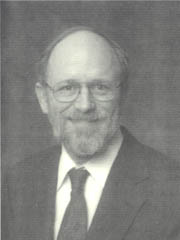2002 Lectureship Recipient

Professor Phillip C. Wankat
Head of the Division of Interdisciplinary Engineering Studies
Purdue University
April 23, 2002
|
Abstract |
|
"Comparing the Dynamic Behavior of Packed and Staged Systems for Concentrated Absorption" |
|
A variety of staged and packed columns are commonly used for absorption. For dilute systems the choice of system depends upon economics since there is not much difference between the steady state and dynamic behavior of the systems. For very concentrated systems the steady state behaviors are again quite similar. Praveen Gunaseelan and I studied the dynamic behavior of concentrated absorbers for the absorption of hydrochloric acid into water and the absorption of ammonia into water. Simulations were done for concentrated absorption with sieve tray columns, randomly packed metal Pall rings and ceramic Berl saddles, and Mellapak structured packing. During startup absorption columns are often brought to a hydraulic steady state with water and air before switching to the feed gas. After feed was introduced, the simulations showed a significant drop in pressure and reduction in gas flow rates caused by rapid absorption. In the sieve plate column this reduction in velocity causes excessive weeping or dumping, which in severe cases can cause column failure. The packed systems were much more robust to this disturbance since dumping does not occur. If mass transfer rates were low, a brief bypassing could occur in the packed columns that resulted in excessive solute in the outlet gas. For realistic mass transfer rates for our systems this bypassing did not increase the gas concentration above specifications. During operation, it may be desirable to switch a unit to stand-by operation. That is, turn off the feed gas and replace it with air or nitrogen. Simulations of all the systems showed rapid desorption, which caused large increases in the pressure and gas flow rates. This "burp" causes a peak of gas and (in the staged column) entrained liquid that often violates the design specifications. In addition, the resulting pressure pulse could displace trays or packing if they are not properly secured. The sieve plate column also suffered from downcomer backup, which can lead to flooding. Design and operating procedures to alleviate or eliminate these problems were devised. However, the solutions are simpler for packed systems than staged systems since the packed systems are naturally more robust for these disturbances. Thus, we recommend packed columns for concentrated. |
|
Abstract |
|
"Teaching Improvement Has Failed - Let's Improve the Learners" |
|
Most studies of teaching innovations show no significant difference in the amount learned when different methods are compared. Active learning methods are an exception and do show a significant difference, but despite this most engineering professors continue to lecture. Student ratings of instructors do correlate with learning, but the highest correlation coefficients that are observed are about 0.5. Thus, 75% of the variance is not explained by the students' perception of the teacher and their perception of what the teacher does in class. It is time to throw in the towel and stop trying to improve teaching in a vacuum. Even if we are successful in improving teaching, the effects on student learning will be modest. We can have more impact by focusing our attention on students and improving their learning. A number of different studies have shed considerable light on how people learn, how students develop, learning styles, and student motivation. The purpose of this lecture is to show how to incorporate this knowledge into an integrated program to make students better learners. After exploring our students' time management and study methods, we need to help students develop a personalized system that will optimize their use of time. Closely coupled with this is improved advising. Students need to be encouraged (forced?) to create a plan of study and keep this up-to-date. Progress must be tracked and students who are not on track must come in for personal interviews. Professors have the responsibility to use teaching methods that involve students and result in increased learning. Various active learning methods including cooperative group learning, computer simulations, studio classes, guided design and problem based learning result in increased student learning. Supplemental instruction helps students who are struggling learn material. Although we would prefer students to be intrinsically motivated, extrinsic motivators are useful. First, parents can help motivate students, particularly if the parents are paying for the students' educations. Making students monetarily responsible often has a major motivating effect. Schools can help motivate students by organizing co-op or internship work sessions. Working in the "real" world strongly motivates most engineering students. Service learning, undergraduate research and tutoring others are additional techniques that motivate many students. Improving student learning does not require further research and study. All of the necessary pieces have been studied and piloted. The challenge for engineering schools is to put these pieces together into a coherent program. |
